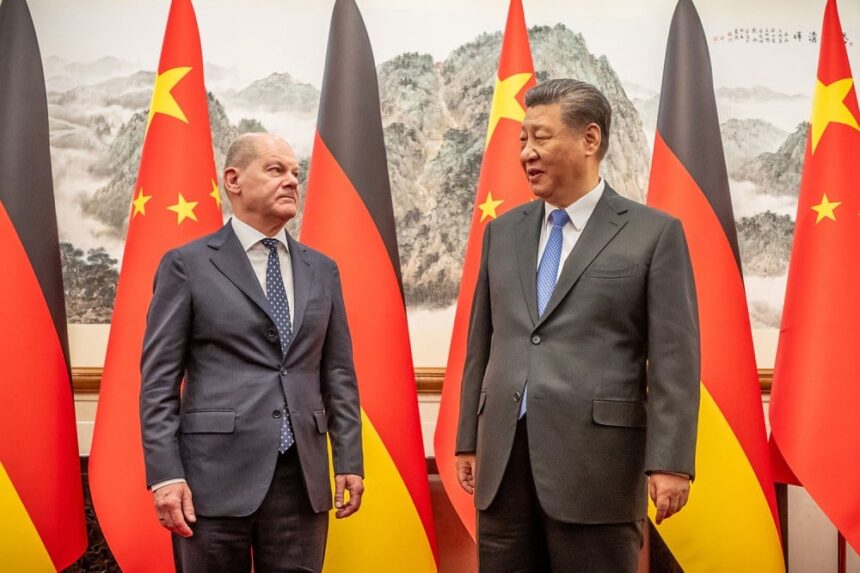Summary by Geopolist | Istanbul Center for Geopolitics:
The article highlights deep divisions between Europe and the United States over how to handle China. U.S. Secretary of State Antony Blinken was set to visit China, bringing tough messages about China’s support for Russia in its war against Ukraine. This stands in stark contrast to the more conciliatory approach taken by German Chancellor Olaf Scholz during his recent trip to China, raising concerns that Germany, and by extension Europe, might be perceived as naive regarding the economic and security challenges posed by China.
U.S. Approach to China:
- Tough Stance on China’s Support for Russia: Blinken’s visit to China includes warnings about China’s support for Russia through the provision of weapons-linked technologies.
- Recent Improvements in U.S.-China Relations: Despite the competitive stance, there have been efforts to stabilize relations, including a productive meeting between Presidents Joe Biden and Xi Jinping in November 2023 and a follow-up call. U.S. Treasury Secretary Janet Yellen and National Security Advisor Jake Sullivan have also engaged with Chinese counterparts to address economic and security issues.
- Ongoing Competition: Even with these efforts, the U.S. remains competitive, with Yellen criticizing China’s unfair manufacturing practices during her visit.
Germany’s Approach to China:
- Economic Focus: Scholz’s trip prioritized economic cooperation, with a delegation including ministers favoring close ties with China and CEOs from major companies like BMW, Mercedes, and Siemens. This approach focused on maintaining strong economic ties while addressing market access and overcapacity issues.
- Lack of Public Confrontation: Scholz avoided making strong public statements on contentious issues such as China’s support for Russia and industrial overcapacity, opting instead for a more subdued approach.
- Economic Dependency: Germany’s reliance on the Chinese market, especially in the automotive sector, remains significant. However, the rise of Chinese EV makers like BYD poses a challenge to German manufacturers.
- Concerns About Naivety: Scholz’s strategy is seen as potentially naive, as it underestimates the challenges posed by China’s growing industrial capacity and its long-term strategic goals.
Strategic Implications:
- Risk of Economic Overreliance: Germany’s heavy reliance on China for economic growth and market access, especially in the automotive and manufacturing sectors, risks making it vulnerable to shifts in Chinese policy and market dynamics.
- Geopolitical Costs: Scholz’s approach may weaken European unity and hinder efforts to build credible partnerships with other Indo-Pacific countries like India and Japan, which have taken more robust measures to reduce dependency on China.
- Challenges to European Competitiveness: The influx of Chinese-made industrial products, including EVs and energy transition technologies, poses a significant threat to European manufacturing. Germany’s strategy to continue economic engagement while hoping to regain competitiveness might not be sufficient to counter China’s industrial dominance.
Alternative Approaches:
- Coordinated European Strategy: A more strategic approach would involve better coordination with European partners and the U.S., presenting a unified stance on critical issues.
- Balancing Economic and Security Interests: Balancing economic cooperation with clear public statements and policies addressing security concerns and unfair practices would strengthen Europe’s position.
- Learning from U.S. Diplomacy: Emulating the U.S. approach of combining economic engagement with tough messages on critical issues could help Germany and Europe navigate the complexities of their relationship with China more effectively.
In summary, the article underscores the need for a more balanced and strategic approach to China, considering both economic and security interests, and highlights the risks associated with Germany’s current policy.
For more details, read the full article here below.
The deep and enduring divisions between Europe and the United States over how best to handle China are on full display once again. U.S. Secretary State Antony Blinken is scheduled to land in China on April 24. Prior to touching down, he threatened tough measures unless Beijing stopped supporting Russia in its war against Ukraine through sending weapons-linked technologies to the Kremlin. German Chancellor Olaf Scholz, by contrast, just wrapped up a China trip that was far more conciliatory in both tone and substance—an approach that leaves Germany, and by extension Europe, at risk of looking alarmingly naive in the face of the economic and security challenges posed by China.
Blinken’s visit follows a period of improving U.S.-China ties. Presidents Joe Biden and Xi Jinping held a productive meeting in Woodside, California, in November 2023, with a follow-up phone call this month. U.S. Treasury Secretary Janet Yellen visited Beijing earlier in April as well. New cabinet-level communication channels have stabilized a relationship that only last year seemed in danger of spinning out of control. Yellen now deals with Chinese Vice Premier He Lifeng on economic issues, while U.S. National Security Advisor Jake Sullivan talks with Chinese Foreign Minister Wang Yi.
The White House views the latter channel as notably successful, in part because Wang now combines the twin roles of foreign-policy chief for both the government and the Chinese Communist Party. This allows a more streamlined communication compared to the time when these roles were split in two.
Yet despite this, the U.S. approach remains basically competitive. Just like Blinken brandishing warnings about Ukraine as he arrives this week, so too did Yellen pepper her trip with tough comments about what she described as China’s unfair manufacturing practices.
Scholz’s approach was markedly different—and not in a good way. This was obvious from the moment that details of his delegation emerged. There are senior figures in Germany with a hard-headed, strategic view of China, not least Vice Chancellor Robert Habeck and Foreign Minister Annalena Baerbock. But neither were in Beijing. Instead, Scholz took ministers in areas such as agriculture, who favor close cooperation with Beijing, along with a bevy of industrial CEOs promoting Sino-German trade and investment.
He also declined to make a big set-piece speech. Indeed, Scholz said remarkably little in public about issues that strike at critical European economic and security interests, from China’s support for Russia to the growing risks of industrial overcapacity. China’s media was understandably delighted. “I would describe the coverage as ebullient,” as Rhodium Group China advisor Noah Barkin wrote following the trip. “Clearly there is a sense that China dodged a bullet.”
Scholz’s approach is rooted in perceptions of German economic interests. These have worsened markedly over the last year. Speaking during the National People’s Congress in early March, Xi demanded that China unleash “new quality productive forces”—code for ploughing huge sums into advanced manufacturing, including electric vehicles (EVs) and batteries, to prop up China’s faltering economic model. Given limited domestic demand, the results will inevitably be exported, putting China on a collision course with advanced manufacturing economies in Europe and North America.
The European Union, which is investigating whether China’s subsidies give a competitive advantage to companies in industries including cars and solar panels, is already considering tariffs on Chinese EVs, as Scholz noted. Yet even in the exceedingly unlikely scenario of China reducing state support, its vast output and low costs make it extremely difficult for Europeans to compete. From EVs to energy transition technologies to simpler types of semiconductors, Europe now clearly risks a future dominated by Chinese-made industrial products.
Berlin faces specific challenges in the auto sector, the most important part of Germany’s vaunted manufacturing industry. China has for decades been the most important and most profitable market for companies such as BMW, Mercedes-Benz, and Volkswagen. That era is now over. China’s BYD now vies with Tesla to be the world’s largest EV maker, producing cars that are roughly as good as and much cheaper than those of its U.S. rival. The streets of Beijing and Shanghai throng with cars made by other Chinese EV brands, most of which are unknown to the Westerners. Demand for traditional combustion engines is collapsing.
Accordingly, foreign brands’ total share of the Chinese auto market has plunged from 64 percent to just 40 percent in the short time since 2020, according to Bill Russo, the former head of Chrysler in China and now head of Automobility, a consultancy group. For now, VW still sells plenty of cars in China, but that won’t last. “It’s hard to see how these companies have a future,” Russo said.
Germany has a second concern: the risk to its market back home. Almost no Chinese EVs are currently sold in the United States because of regulations targeting Chinese-made batteries and other components. Facing a wave of Chinese EV imports, Europe is likely to raise tariffs to roughly the same level as the United States.
Scholz, however, has faced the opposite demands from his own automakers. Mercedes-Benz CEO Ola Källenius, who has invested heavily in the transition to EVs, called on Brussels to cut EV tariffs rather than raise them, arguing that competition will spur European carmakers to improve. And there is some truth to the idea that simply shutting China out of the European market is unlikely to help Germany regain competitiveness in EVs. For that, German companies need access to Chinese technology in areas such as batteries, at least until they have time to figure out how to make their own. Germany also fears that European tariffs will lead to reciprocal measures targeting German automakers in China.
Viewed charitably, therefore, Germany’s approach is a variant of the famous adage by then-Citigroup CEO Chuck Prince in the run-up to the 2008 global financial crisis. “As long as the music is playing, you’ve got to get up and dance,” he said in 2007, trying to explain why his bank kept ploughing ahead with risky financial trades even as signs of approaching calamity became clearer. In much the same way, Scholz hopes German companies can keep making money from what remains of their Chinese market while they try to regain their old global competitiveness.
The odds of this working out are slim, of course, given China’s growing industrial might. But even if it does work, the strategy still makes the old mistake of confusing what is good for German companies with what is good for Germany and Europe more generally.
This approach looks naive for two reasons. The first is that China’s course is now set. Speaking to students in Shanghai, Scholz called for China to moderate its behavior. “Competition must be fair,” he said, calling for Beijing to avoid dumping and overproduction. But China’s system is now far enough down this path to make such demands impossible, even were Beijing minded to listen, which it is not.
On the contrary, China is bulking up its manufacturing sector to revive its economic model. It has no interest in allowing German car companies to thrive in its market and every interest in becoming the globally dominant leader in EVs and other industries. German automakers might labor under the misapprehension that their position in China can be saved, but there is no need for its political leaders to believe the same fiction. Scholz’s softly-softly approach also does little to prepare Germany’s population and companies for the massive challenges to their own economic model that come with Chinese competition.
Germany’s approach then comes with a second set of geopolitical costs to European and Western unity. As China’s glowing media coverage shows, Scholz’s trip was a gift to Beijing’s long-held approach of seeking to divide Europeans among themselves—and from the United States. This division was clear enough over trade. But it was there, too, on Ukraine. Scholz’s office noted that the chancellor raised Ukraine in a private meeting with Xi, arguing that Russian “rearmament” has “significant negative effects on security in Europe” and directly affects European “core interests.” Yet private messages asking China to cease supporting Russia seem unlikely to be effective when similar public messages have already failed.
Germany’s approach also now makes it harder for Europe to build credible ties with new partners in the broader Indo-Pacific, including India and Japan, which have each taken serious measures over recent years to reduce their dependency on China. Indian and Japanese leaders are also frank and open about the economic and security threats China poses. Viewed from New Delhi or Tokyo, Scholz’s trip will simply be taken as evidence of Europe’s unreliability and strategic unseriousness.
Germany’s approach seems especially odd given that there are clearly better templates. Blinken’s and Yellen’s trips show that business can be done in Beijing while delivering tough messages. European Commission President Ursula von der Leyen struck a similar balance on de-risking during the most recent EU-China summit in Beijing last December. Dutch Prime Minister Mark Rutte did much the same in March, openly criticizing Chinese cyber-espionage tactics and support for Russia on Ukraine.
It is possible to imagine a different German trip, in which Scholz coordinated with European partners and Washington, arrived in Beijing with his most capable ministers, and was willing to state a joint policy firmly in public, complete with clear carrots and sticks. Instead, Germany’s approach seemed to lack long-term strategic acumen. Its policymakers bristle at the notion that Germany’s economic and foreign policies are set in corporate boardrooms, rather than the chancellery and ministries in Berlin. But it is hard to explain Scholz’s trip—and, dispiritingly, much of Germany’s China policy—in any other way.
By James Crabtree
Source: Foreign Policy







